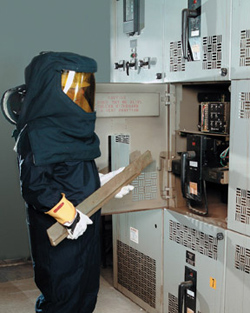Arc Flash Clothing

Arc Flash Clothing
Arc flash clothing is essential to keep electrical workers safe from injury and death. OSHA statistics demonstrate that five to 10 times each and every day, an electrical worker in the North America is either injured or killed as a result of being caught in an arc flash accident. These injuries and deaths from these electrical explosions devaste the lives of electrical workers and their families. Had these electrical workers been wearing the correct level of arc flash clothing protection, the number of injuries and deaths might have been much less.
Arc Flash Clothing and NFPA 70e
Arc Flash Clothing Defined by NFPA 70e - OSHA 29 CFR 1910.269 (1)(6)(iii) states: “The employer shall ensure that each employee who is exposed to the hazards of flames or electric arcs does not wear clothing that, when exposed to flames or electric arcs, could increase the extent of injury that would be sustained by the employee. Clothing selected for a particular application shall have an arc thermal performance value of (EBT or ATPV) higher than the potential hazard to prevent the onset of 2nd degree burns.
Different types of arc flash clothing have different ratings. For example, gloves have a voltage rating to protect from electrical shock. Cotton and fire retardant (FR) clothing all have thermal ratings. The following table shows the level of arc flash clothing required for each level of hazard.
NFPA 70e addresses electrical safety-related work practices and procedures for employees who work on or near exposed, energized electrical conductors or circuit parts. This standard requires that electrical workers wear flame resistant arc flash clothing that meets the ASTM requirements where there is possible arc flash and arc blast exposure. OSHA has formally adopted NFPA70e and will cite employers under the general duty clause.
Electrical workers can be protected from arc flash and arc blast by wearing arc flash clothing and gloves, tools, face protection, and glasses. Arc flash clothing is to prevent burns that could cause injury and possible death. The head and chest areas of electrical workers are the most critical areas and must be completely protected. Although arc flash burns to an electrical worker's limbs are serious, they are usually not likely to cause a fatality.
- Read More Here: Arc Flash and Electrical Safety
- Read More Here: Electrical Training Courses
- Read More Here: CSA Z462 Arc Flash Training
- Read More Here: NFPA 70E Arc Flash Training
- Read More Here: Electricity Forum
For more information, see:
On-site training
Interested in cost effective, professional on-site electrical smart grid training?
We can present an On-site Training Course to your electrical engineering and maintenance staff, on your premises, tailored to your specific equipment and requirements. Click on the link below to request a FREE quotation.
Live Online Electrical Training Schedule
Arc Flash Group Training

We can present this Course to your electrical engineering and maintenance staff, on your premises, tailored to your specific equipment and requirements. We are ready to help design this program for you. Click on the link below to request a FREE quotation.
